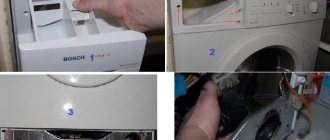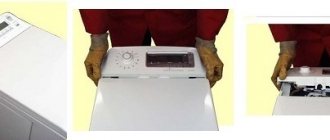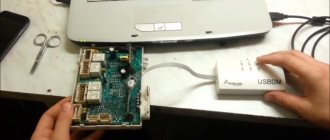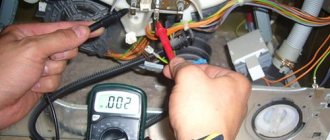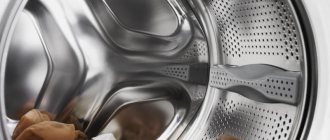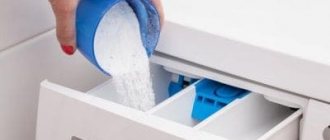A washing machine breakdown is an unpleasant problem that requires an immediate solution. If the equipment is under warranty at the service center, there is no point in troubleshooting it yourself. When the warranty period has expired, you can try to set up the unit yourself.
To do this, you will need a basic set of tools and a manual that tells you how to disassemble the washing machine. We suggest that you familiarize yourself with the detailed instructions. With such an arsenal, even an ordinary home mechanic can restore the device.
Potential problems and breakdowns
In order not to make unnecessary efforts, it is advisable to observe the equipment and understand what exactly is the deterioration in performance. If the overall quality of the wash has dropped, an uncharacteristic noise appears during the spin cycle, and the laundry remains wet after the spin procedure, the problem most likely should be looked for in the pump.
The same unpleasant phenomena are caused by clogged communication hoses. It is better to approach all these components from the front of the unit or from below. If foam comes out of the machine during operation, you need to stop washing, set the “Drain without spin” program and wait until the device completes all the necessary actions and opens the door.
Then you should remove the laundry, manually clear the foam from the inside and start the wash again without spinning. If this is not done, foam will penetrate into the engine or onto the control board, and repairing these components will cost the owners a substantial amount.
The reason for the appearance of abundant foam in the washing machine may not be a breakdown or malfunction of the unit itself, but the use of hand washing powder (it does not contain defoamers) or a significant excess of the standard dose of detergent
If the device does not gain temperature and does not warm up the water, it is most likely that the working heating element has failed. Its location is indicated in the accompanying technical documentation. It is usually located at the rear, but in some models, depending on the manufacturer and internal design features, it may be located in the front.
It may have built up scale as a result of using hard water and will need to be cleaned. Or, if the element burns out, you will need to replace it with a new heating element. The replacement process is described in detail in our recommended article.
If the machine takes a long time to wash, you should look for a fault in the electronics. It would be a good idea to check the functionality of the water temperature sensor and other controls. The same problem can occur due to an incorrectly placed drain hose.
A pressure switch or pump is responsible for uniform and rapid drainage of liquid from the washing container. Slowly pouring water clearly indicates that these elements have lost their functionality due to breakdown or operational wear.
To repair them or replace them with new ones, you will have to dismantle the side wall and penetrate into the upper part located behind the rear panel.
When failures occur in the drum or bearings, you will have to completely disassemble the device, identify the problem, carry out repairs, and then assemble the machine and start it up. If washing proceeds as usual, then operation can be continued.
This is just a short list of the main breakdowns identified in the machines. It is relevant for all household washing equipment, regardless of the brand and design features of each individual device.
Problems with electronics and software control are more complex problems and require professional intervention. To eliminate breakdowns of this level, regardless of whether the equipment is still under warranty or not, it is better to contact a specialized service center.
The certified technicians working there will carry out diagnostics, quickly identify the source of the malfunction and repair the damaged electronic unit or replace it with a new one.
Top tips for maintaining an old car
Your vehicle's manual usually contains a maintenance schedule for certain items. Follow the manufacturer's recommendations. This will help extend the life of your car.
Here's a short list:
- Change the oil and oil filter regularly.
- Keep all fluids filled properly.
- Change spark plugs more often.
- Replace coolant.
- Check the brake fluid.
- Use tires and rims recommended by the vehicle manufacturer.
- Check your tire pressure once a month and before long trips.
- Don't forget the spare tire, check its pressure.
- Be sure to perform other maintenance as needed in accordance with the vehicle manufacturer's recommendations.
Nuances of the preparatory process
Before you begin disassembling the washing machine, you must carefully study the accompanying documents included with the equipment, study the electrical diagram and become familiar with the structural design of the unit.
The next step is to do the following:
- carefully disconnect the device from the electrical network and water supply system;
- disconnect the drain hose from the sewer outlet;
- select a set of tools required for the work ahead.
Only after such thorough preparation can you proceed directly to disassembling the washing unit.
Dismantling of the housing and internal parts must be carried out in a strictly established order, otherwise there is a risk of damaging individual serviceable elements. As a result, you will have to replace not only broken parts, but also those that were damaged during improper assembly.
It is advisable that the craftsman have a sufficient amount of time at his disposal, since the disassembly/assembly process does not tolerate haste and fuss. In addition, all repairs must be carried out carefully and delicately, without causing harm to other internal and external parts of the unit.
Repair work after disassembling the machine
To understand what exactly was drained and where the malfunction occurred, you can resort to error codes that are displayed on the displays of almost all models of washing machines (in particular, LG, Indesite and others). If such prompts are not indicated on the display, then you will have to determine the cause of the malfunction based on “symptoms”, external inspection of parts and some nuances.
Timely diagnosis plays an important role
So, to identify faulty bearings at the tank, you need to open the door leading to the hatch and slightly lift the drum. If serious loft is noticeable, the bearings must be replaced or repaired.
List of required tools
To correctly disassemble the washing machine, a home craftsman will need the following tools:
- wrenches (size 8, 9, 19);
- service hook;
- screwdrivers (classic flat and Phillips);
- pliers and wire cutters used for self-clamping clamps;
- ordinary wire cutters;
- pliers with an insulated rubberized handle;
- bent long pliers.
Almost all of these items will definitely be found in your home arsenal, and the missing items will simply need to be purchased at a hardware store or borrowed from friends or neighbors.
If the machine runs for a long time, some screws may “stick” to the cells. Unscrewing them will be problematic, so it makes sense to use WD-40. A few drops will soften the joints and facilitate correct unscrewing of the connecting parts.
In addition to all the items listed above, it is worth stocking up on a medium-sized basin, where it is convenient to drain the remaining water in the hoses, and several microfiber cloths. They can be used to wet your hands, wipe the internal parts and collect the remaining working fluid that has spilled from the tubes from the floor.
Typical faults
Thanks to the washing machine, the housewife can significantly save time and effort. If suddenly it doesn’t work, life turns into uncomfortable. But not in every case it is necessary to completely disassemble the washing machine. Some breakdowns are easier to fix.
There are malfunctions that manifest themselves as follows:
- The water does not heat up. Most often, the heating element is to blame for such a malfunction. A much less common cause is a power supply circuit break. And very rarely this happens due to faulty sensors or a malfunction of the control unit.
- No water flow occurs. For water to flow normally, normal pressure is required. If it is absent, there is no water. This often happens when the water tap connected to the machine is closed. If some time has passed since the start of washing, this indicates that it is clogged.
- As soon as the machine fills with water, it immediately drains it. This may happen due to the fact that the device is not connected correctly to the sewer. Self-draining may not appear immediately, but only after some time after the start of operation. Another reason is a serious internal breakdown, which disrupts software control.
- Water appears under the car. If the curtains were washed before, there is nothing to worry about, it’s just that a large amount of foam was formed in the process, which eventually leaked through the technical hole. The reason can also be attributed to poor laying of the hose through which water is supplied. To resolve the problem, it is enough to replace it.
- Water does not drain. Cleaning the drain pump filter is usually sufficient. If you repeat this procedure regularly, no problems should appear.
- The washing machine makes a lot of noise when working. This symptom indicates a problem with the mechanism. There may be a foreign object in the tub, or the laundry in the drum may not be evenly distributed. It is also possible that the machine itself is installed incorrectly or the bearings are faulty.
Instructions for disassembling washing machines
Structurally, washing machines, even those produced by different manufacturers, are very similar to each other. They have the same basic “filling” and work on the same principle. The main difference that matters during disassembly is the loading method - frontal or vertical.
All other criteria relate to external decorative fragments, small internal parts, fasteners and are not of significant importance.
Detailed description of disassembling the front washing machine
Front-type machines differ from their analogues in that they load laundry through a round door located on the front part. On the one hand, this is convenient and practical, on the other hand, it requires special attention and caution when removing the glass loading hatch during disassembly and repair.
When disassembling the machine and making repairs, you need to act carefully and carefully. Most of the body fragments are made of plastic and are vulnerable to mechanical stress. If impacted or overloaded, they may crack and the appearance of the unit will lose its aesthetics.
Equipment does not always need to be completely disassembled, as they say, down to the screw. Knowing how the device works and understanding the nature of the problems that appear, you can at least roughly determine the area where the problem is located.
This will help to start disassembly exactly where it is easiest to get to the failed element without touching normally functioning parts.
When the power button does not work, you need to check the electrical connection. If the connection is OK, then activation is blocked by an internal fault. It is unlikely that you will be able to diagnose it yourself. It is better to invite a specialist and instruct him to find the problem
We invite you to familiarize yourself with the step-by-step instructions that will help you cope with the volume of work yourself.
To disassemble a front-type machine, you must proceed in the following order:
- Remove the top panel . Using a Phillips-head screwdriver, carefully unscrew all fasteners holding the top panel of the device. Gently pull the cover towards you and remove it, being careful not to damage the fragile internal elements.
- Remove the detergent container . Empty the container responsible for distributing detergents. To do this, gently press the special zone located in the central compartment of the tray with your fingers. After all these manipulations, the container can be removed without any problems.
- Remove the control unit . To do this, you need to unscrew the screws in the upper area of the front panel, carefully unscrew the block 90 degrees and carefully remove it from the fasteners. Using the service hook, securely secure the panel to the side of the unit.
- Disconnect the connectors with wires by simply pulling them out of the corresponding grooves located in the control unit. This point is relevant if the design of the washing machine requires it.
- Remove the service panel by carefully prying it off with a flat-head screwdriver. To get to it, you have to unscrew the screws facing the sides at the bottom, on the front side of the device.
- Separate the rubber sealing collar from the center panel. To do this, use a screwdriver to release the clamp from the grooves holding it.
- Unscrew the screws holding the central panel to the body and remove the entire element.
- Disconnect the front hatch locking connector.
- Carefully remove the rear outer panel and set it aside. If necessary, unscrew the mounting screws and the tightening bolt of the drum assembly.
- Remove the fixing clamp with pliers and carefully remove the inlet hose that goes to the tank. Using the same principle, disconnect the hose going to the pressure switch.
- Remove the counterweight blocks located at the front or rear (depending on the model) to ensure a stable position of the unit on the floor during operation and spinning, after first unscrewing the long mounting bolts.
- Remove the heating element . In most models it is located on the back side in the lower compartment of the case. Some manufacturers also place it low, but in the front area of the tank. To disconnect correctly, you need to unscrew the fixing nut located in the center. Then press on the protruding pin and push it inside. Pry off the heating element with a flat screwdriver and carefully remove it.
- Remove the tank . To remove the tank, you will need to twist the lower shock absorbers, remove the springs, and only then will you be able to remove it.
- Disassemble the tank itself . If there is a need for this, then first twist the bolt securing the pulley, press the shaft inside the tank, remove the clamp and divide the tank shell into two halves.
After the machine is disassembled, you can begin repairing and replacing failed working elements.
Some washing machines are equipped with a one-piece disposable tank that does not require disassembly. Home craftsmen, if necessary, cut this part with a hand saw, and then assemble it together, fastening it with elongated bolts and waterproof, durable sealant
When all the necessary activities are completed, you will need to reassemble the unit, install it in its original location, correctly connect it to the central communications and test it for functionality. If everything is done correctly, the machine will function as usual and will not cause any more trouble to the owners.
Disassembling a top-loading washing machine
For vertical washing machines, the most common negative phenomena are spontaneous opening of the working drum, corrosion of the metal block, imbalance of the central moving unit during washing and bearing failure.
In vertical units, the upper door seal loses elasticity over time and becomes deformed. As a result, puddles appear under the machine, and rust forms on the body. To fix it, you need to remove the control panel, remove the seal and install a new one.
To troubleshoot such problems, the equipment will definitely have to be disassembled. This process is labor-intensive and requires a lot of attention and concentration.
But this does not mean that it is impossible to repair a vertical unit at home. You just need to strictly follow the instructions and be careful. Then everything will go smoothly and getting to the problem node will not be difficult.
We offer a step-by-step description of the process for independent craftsmen. Before you begin disassembling a washing machine with a vertical type of loading laundry, you need to disconnect it from the central communications.
Then place the machine in a convenient place so that it does not disturb anyone living in the room. Next, you need to prepare specialized tools and stock up on a basin and a rag to immediately wipe away any remaining water that has spilled onto the floor from the communication hoses.
Now you can start disassembling the equipment and take the following steps:
- unscrew the fixing screws located on the sides of the device;
- carefully move the base working unit towards you and disconnect the electrical wires;
- remove the control panel;
- remove the dispenser for powder and other detergents;
- remove the side and top panels;
- remove the fastening clamp;
- carefully remove the plastic casing, being very careful not to damage it in any way;
- start repairing equipment.
When disassembling a washing machine, you need to remember exactly the order of the wires and internal elements.
To guarantee, it is appropriate to photograph all the components so that you can then assemble the unit correctly and strictly in the same sequence as it was originally.
A washing machine that is not assembled correctly after repairs will not work properly. The use of such a unit may result in a short circuit, spontaneous combustion and other negative phenomena.
Upon completion of the repair of the washing machine, all that remains is to return the equipment to its original place, connect it to the main communication nodes and activate the washing mode. If the work goes as usual, and the device does not malfunction, it means that the home technician did an excellent job and did everything absolutely correctly.
Brands of cars with similar motors
Modern automatic washing machines of the global brand Samsung are equipped with inverter engines. In addition to this advantage, the CrystalStandard series of washers can offer the user “Eco Bubble” technology, or in other words, a bubble washing method that will ensure high quality removal of the most difficult stains. The enormous functionality of Samsung models will allow you to select washing parameters for any type of fabric, and a large number of interesting additions will make the process of using the device even more convenient and enjoyable.
The Yukon series of washing machines with inverter motors is also equipped with the Eco Bubble function. The unit has the ability to clean clothes during a “dry wash” using steam. This ability will be relevant for products made of wool, holofiber and suits.
The famous brand LG can offer customers the latest development - inverter machines operating on the direct drive principle. We are talking about models of the “DirectDrive” series. They operate almost silently, without creating any inconvenience for family members, even at night.
It is worth highlighting the 6 Motion model, which has the ability to rotate the reel in six different modes:
- standard - most often used during the main wash;
- reversible - helps to dissolve washing powder well;
- rocking - it is recommended to turn it on at the stage of soaking the laundry;
- torsion;
- saturation - allows you to evenly distribute powder and other detergents throughout the fabric);
- smoothing – provides for washing without strong creasing, provides easy ironing.
SMAs equipped with inverter motors presented on the household appliances market continue to prove their reliability and efficiency. European manufacturers Electrolux, Bosch, Whirlpool have also been producing automatic machines with a similar engine in recent years. The AEG brand gives a ten-year guarantee on inverter washing machines, because it has no doubts about their quality and reliability. If you prefer to buy domestically produced equipment, you can study the Belarusian Atlantas.
Subtleties of disassembling cars of different brands
Washing machines made by different manufacturers are generally similar and perform the same set of basic functions. However, there are significant differences in the design of the units and the arrangement of internal working parts.
For many popular washing machine models, the heating element is located in front. To get to it, you just need to remove the front cover and carefully remove the part for subsequent repair, replacement or cleaning.
For correct disassembly, it is very important to know the specific unique features of the model to be repaired. Then the work will be easy and you will be able to penetrate the fault zone without any problems.
Steps to disassemble Samsung machines
Samsung household washing machines are quite easy to disassemble. The container for loading powder is located conveniently and is held on by only two screws. The working heating element is located at the bottom of the tank directly under the front cover and getting to it is not difficult.
If the door of a Samsung washing machine does not open, the problem should be looked for in the control module. It is quite difficult to cope with such a plan on your own. It is better to transfer this work to specialists from the service center
You can learn more about repairing Samsung washing machines in a step-by-step guide, which is given in our recommended article.
The nuances of repairing models from Ariston
In Ariston products, bearings and tank seals most often fail. The design of the model is thought out in such a way that this unit cannot be repaired. But for skilled and experienced home craftsmen there are no barriers.
To replace the seal, the solid tank is flared or sawed with a handsaw. There is no other way to restore parts, except, of course, by purchasing a new tank and installing it at the company’s service center.
A bad engine in Ariston equipment is a common occurrence. To repair, you need to unscrew the bolts, remove the back of the housing, and then remove the assembly. If after diagnostics it turns out that the element cannot be repaired, you will have to buy a new one and install it in place of the old one
The latest generation Ariston washing machine models are equipped with self-diagnosis devices, which significantly speeds up the process of troubleshooting. Codes of malfunctions and operational errors are displayed on the display, notifying about an emerging or impending problem. Decoding them will help you understand what should be repaired and how.
Procedure for disassembling Atlant washing machines
Atlant brand devices are practically designed and can be repaired. At the very beginning of disassembly, it is necessary to remove the counterweight, and then remove the external control panel. The drum in these models consists of two halves, secured with bolts, so any working parts can be replaced in no time.
Models from the Atlant company have a built-in self-diagnosis system. In the event of a malfunction, the electronics displays relevant information on the display. Owners can read the message, consult documentation and determine how to fix the problem
Specifics of Electrolux brand machines
Electrolux machines are very reliable and rarely break down. Our rating will introduce you to the top ten Electrolux washing machines in sales. The front panel can be easily removed and immediately provides access to all the main components and parts.
Working bearings and oil seals are placed on separate removable supports. To replace them, you do not need to completely disassemble the drum.
If the working drum in the Electrolux washing machine does not spin, most likely the brushes, drive belt, motor or control board are damaged. You can look for the problem yourself, but the technicians from the service center will do it faster and at the highest professional level
Features of LG washing equipment
LG household washing appliances have a complex design. To remove the front panel, you will first have to use a screwdriver to unscrew the nuts that securely fix the hatch cover. Then you have to carefully remove the screw that tightly tightens the clamp to hold the cuff.
To make it easier to deal with disassembling washing equipment, you can visually study the design features of the unit by looking at this diagram
Then you will need to remove the weighting material located on top and only then carefully remove the tank to be repaired or replaced.
The South Korean manufacturer equips its new models with a self-diagnosis system. Deciphering error codes will help you quickly and accurately determine what needs to be changed and where to repair. It will allow you to immediately decide whether it is worth doing the repairs yourself or whether it is better to go to a workshop.
How to disassemble the tank and drum
In some brands of washing machines, the tank can be disassembled by unscrewing the bolts connecting its two halves. But in most modern models, these parts are non-separable, and the halves are soldered at the seam. How to disassemble a washing machine drum located inside a solid tank?
In the photo you see a non-separable washing machine tank in which the drum is located
Begin disassembling the tank by removing the pulley (the wheel through which the belt passed). The bolt that secures this part can be additionally secured with glue. If you can’t unscrew it, you can treat the part with WD-40 or carefully knock it off the glue with a hammer.
Unscrewing the bolt that secures the pulley can be very difficult
The tank is divided into two halves using a hacksaw (you need to cut along the seam, where they are soldered). To make it easier to assemble later, holes are first drilled around the entire perimeter of the seam using a drill. During assembly, bolts will be threaded through them to hold the parts together.
It is easy to remove the drum from the open tank by disconnecting the fasteners. Now you can remove the oil seal and bearings from it.
The bearing assembly usually consists of two metal elements and a rubber gasket - oil seal. Disassembling the drum begins with the bearing located closer to the outer part. The drum is placed with the hole down, and the metal ring is knocked out using a chisel and hammer.
You will need a hammer and chisel to remove the bearing from the drum.
Actions when removing bearings must be careful and precise - the chisel must be installed strictly on the outer ring. If the tool slips and the inner ring is struck, it may fly out, and removing the remaining parts from the socket is a very difficult process. We remove the second bearing in the same way, and then remove the oil seal.
Conclusions and useful video on the topic
A detailed description of how to independently disassemble a Samsung washing machine with a front-loading type of laundry. Interesting design features of the model and curious nuances that arise during disassembly:
How to properly disassemble an LG washing machine at home. Detailed execution of all processes step by step:
Disassembling a washing machine is a meticulous process that requires attention. If the breakdown concerns only a separate part of the system, there is no need to completely disassemble the unit. If malfunctions are observed in the main components, efforts will have to be made to fix the problem.
Our step-by-step instructions will help with this, clearly describing the process. Having such a cheat sheet at hand, even a person with minimal experience can handle repairing a washing machine. If you still have questions, ask them in the comments and we will try to help you.
Tell us about how you disassembled the washing machine for repairs with your own hands. Share what difficulties you encountered and how you solved the problems. Please leave comments in the block form below, ask questions and post photos on the topic of the article.
Step-by-step instruction. Machine disassembly
- Top panel. It is secured with several screws, tightened with a Phillips screwdriver, at the very top of the rear panel. First you need to unscrew these screws, then press a little on the cover from the front, and then from the top.
- Dispenser for household chemicals (powder). To pull out this part, you need to find the plastic button in the center of this tray, press it, and then pull it towards you - this way this element will be pulled out.
- Removing the control panel. To secure this element of the washing machine, only a few screws are used. One is usually located just under the detergent containers, and the other is in the opposite place. It is a very fragile part so you should proceed with caution. To avoid damaging it, place it either on top of the machine or hang it on a special hook.
- Removing the service panel This part is necessary for service and selection of small items that accidentally got into the washing machine. Removing this part of the washer is quite simple: you need to tighten two latches located on the side and the third one located in the middle. It is extremely rare that it can be secured with additional screws.
- Front panel. To begin, you will need to carefully remove the rubber clamp after loosening it. It is located on the loading hatch. Most often it is attached using a small elastic spring. To remove it, the spring must first be pryed off. Now the cuff needs to be pulled together in a circle (a screwdriver and pliers will come in handy here). If during the process the cover interferes with the disassembly process, it can also be removed by unscrewing a couple of bolts, but if it does not cause any inconvenience, it is better to leave it in place. Now you need to find all the fixing parts on which the front panel is attached. The electrical connector must be pulled out of the device blocking the hatch. Done - the part has been removed.
- Back panel. It is extremely easy to remove; all you need to do is unscrew the screws around the perimeter. There can be quite a lot of these screws.
Which brand should you prefer?
Having decided on the functionality that you really need, proceed to solving an equally difficult task - choosing a device brand. How to choose the right washing machine from the manufacturer’s point of view? Even experts do not undertake to definitively answer the question of which brand makes the best washing machines. Any brand of equipment has both pros and cons.
Such popular brands of washing machines as LG, Beko, Indesit, Samsung, Hotpoint Ariston, Candy, Whirpool, Gorenje, Zanussi, Atlant are famous for their fairly good quality and decent functionality. These manufacturers often top sales rankings, because they produce a wide range of equipment designed to suit every taste and budget. The cost varies depending on the set of functions, so the buyer can choose a model in both the budget and mid- or high-price segments.
Some manufacturers lure buyers by offering good service support.
The most popular brands in terms of price and quality ratio are Siemens, Bosch, Electrolux, AEG, Hitachi. The cost of such washing machines may differ markedly from units of the previous category, but this is justified by maximum reliability. Manufacturers focus on high quality assembly and materials, and also offer a large selection of models, including budget lines of washing machines.
Bosch washing machines have long won the trust of consumers
It would not be amiss to mention the manufacturers of luxury equipment - Miele, Smeg, Asko, Schulthess. The products of these brands are expensive, but they are of high quality and can last more than 15-20 years. It is usually purchased for professional use, for example, in laundries. Also, the buyer has to overpay for the exclusive design of devices that some brands offer.
Algorithm of actions
For each type of Electrolux washing machine (depending on the loading method), a specific parsing algorithm is prescribed.
Horizontal loading household appliance
The body of a front-loading washing machine consists of two halves (back and front, connected by fasteners along the side line).
Taking into account this design feature, the Electrolux washing machine is disassembled as follows:
- We find two screws located on the back wall of the case and unscrew them. We slightly push the cover towards the back wall, lift it and remove it from the body.
- On the left and right side panels, unscrew the two screws that secure the rear panel.
- At the bottom of the rear panel, unscrew the two fasteners.
- On the sides, after opening the plugs, unscrew the fixing bolts.
- Unclench and lift the plastic holders that secure the panel in the upper part of the case.
- Remove the back panel.
- Inside the powder receptacle we find a plastic tab, press it, and carefully pull the dispenser out of the washing machine body.
- We unscrew the fastening bolts and remove the hatch door along with the hinge.
- Carefully prying up the clamp spring with a slotted screwdriver, pull the metal ring off the cuff. We put the rubber seal inside the drum.
- We unscrew the screws located on the left side of the control panel, carefully use a screwdriver to open the latches on the top and sides of the panel, without disconnecting the wiring, remove the control unit.
- We unscrew the screws located around the hatch lock, under the control panel and around the drain filter, and remove the front panel from the body.
- Hold the pulley with one hand and remove the drive belt with the other.
- We unscrew the fasteners holding the motor, disconnect the terminals of the power wires, move the motor slightly toward itself, and remove the mechanism from the housing.
- Disconnect the wires from the drain pump, unscrew the fasteners, carefully turning clockwise, and remove the pump from the housing.
- We disconnect the wiring from the heating element, unscrew the central bolt (located between the contacts) and, using gentle rocking movements, remove the heating element from its seat.
- Having unscrewed the central bolts, we dismantle the counterweights.
- Using pliers, pull out the pin holding the shock absorbers and remove the paired elements from the bottom of the tank and the body of the washing machine.
- In the upper part of the housing, we disconnect the powder receiver pipes, the wiring of the filling valve, the springs, after first disconnecting the tube, we dismantle the pressure switch.
- Carefully lifting it, remove the tank from the springs and remove it from the housing.
At this stage, the analysis of the Electrolux front-loading washing machine is completed.
Rules for disassembling the tank
You need not only to know how to disassemble the drum on a washing machine, but also to properly prepare for it.
While working, do not forget that:
- The tub and drum are removed from the washing machine very carefully. Most modern tanks are made of plastic, and this material is subject to the slightest mechanical stress. You may need a friend's help when removing the tank.
- If your tank is non-separable, you will have to saw it. Before this process, it is recommended to drill many, many holes along the seam using a thin drill to reassemble the part. This way you will avoid the halves moving and ensure a good seal. Stock up on sealant.
- When cutting a tank, it is forbidden to make a bevel, even a couple of millimeters, to the side.
- The screw that holds the drum pulley cannot be unscrewed without force. But, excessive efforts will most likely rip off the head, thereby causing unnecessary problems.
- The back part of the part can be removed from the shaft by lightly hitting it.
- If the bearing is stuck, a car puller can come to the rescue. It is allowed to heat it with a blowtorch before removing it.
Features of disassembling units with vertical loading
Top-loading washing machines have most of the parts the same as front-loading models: tank, drum, motor, shock absorbers, etc.
In the photo you can see the structure of a top-loading washing machine
To disassemble such a unit, you will also have to remove the side panels of the case and the top cover, but you need to start with the control panel. The bolts holding the part can be found on the sides, and in some models it is secured with special latches. In this case, the panel can be pryed off with a screwdriver and carefully moved, disconnecting the wires. Under the part there is a control board, which also needs to be removed.
Then remove the top cover (its fastenings can usually be found under the control board) and side panels, and carefully disconnect the clamp from the drum.
Further actions will consist of sequential removal of all parts. The bearings in a top-loading washing machine are located on both sides of the drum.
Do not forget that the operating instructions for your unit contain a diagram of the location of all parts and their fastenings. Take your time, act carefully, and you will succeed.
Features of disassembling units with vertical loading
How to disassemble an Indesit top-loading washing machine? The procedure will not differ much from that described above, because the device contains the same elements as a front-loading washing machine (pressure switch, water intake valve, drum, tank, control board, pump, etc.). The main differences are that the axis of the “vertical” drum is structurally made on two bearings, and sometimes a self-positioning sensor is located on the tank (fixing the drum with the flaps up).
In the photo you can see the structure of a top-loading washing machine
We begin to disassemble the unit from the control panel by unscrewing the screws holding it on the sides or simply prying the part with a screwdriver and sliding it towards us, not forgetting to disconnect the contacts. Under the panel there is a control board, which we also dismantle.
Then remove the top cover (its fastenings are usually located under the control board) and side panels, carefully disconnect the clamp from the drum.
Further actions will consist of sequential removal of all parts. The bearings in a top-loading washing machine are located on both sides of the drum, so removing them will take a little longer.
We will be glad if our article helps you repair your washing machine yourself. Follow the instruction manual, take your time, be careful, and you will succeed!
The engine undergoes a similar process.
The wires of the electric motor of the washing machine also need to be disconnected, and we strongly recommend taking a photo of them: the photo will only take 1-3 MB, but it will give you self-confidence and the opportunity not to make mistakes when subsequently assembling the machine.
Wires for some unifying reason can be fastened with a plastic tie, and therefore all such “sets of wires” should be carefully removed from the machine so that they do not interfere and are not subject to any influence in case the situation gets out of your control .
More: LG washing machine does not drain water, what to do
Why does it appear and what to do?
The process of eliminating error E40 of the Electrolux washing machine is carried out according to a clearly defined algorithm, starting with the simplest actions, gradually moving towards more complex repairs that require certain knowledge and training.
Checking the tightness of the hatch door
The first thing you need to do when the washing machine signals a malfunction with error E40 is to open the door, check the rubber seal of the hatch for stuck debris, and close the hatch door again (press until it clicks).
Additionally, check the condition of the hinges (door misalignment can also trigger error E40). It is enough to tighten the fasteners that have become loose over time so that the hatch door fits hermetically to the body of the washing machine again.
Testing and changing the hatch locking device (UBL)
The absence of a characteristic click when closing the hatch doors is a signal that the possible cause of the E40 error lies in a malfunction of the hatch locking device (UBL).
Algorithm of actions:
- Open the hatch of the washing machine.
- Using a flat screwdriver, carefully pry it off and tighten the metal ring (clamp) holding the rubber seal of the hatch inlet.
- Having bent the cuff, using a Phillips screwdriver or a tool with an asterisk attachment, we unscrew the fasteners holding the UBL.
- By pulling the lock to the left, carefully remove it from its seat.
- We check the dismantled lock with a tester. To do this, switch the multimeter to the “Resistance” mode. We apply one probe to the neutral contact, the second to the phase. The tester changes the readings - the UBL is working.
- We apply the tester probe to the neutral and common contact. If “0” is displayed on the multimeter display, the UBL is faulty and requires replacement.
- We disconnect the faulty lock from the wiring and connect a new part in its place.
After replacing the lock, return the clamp and rubber cuff to their original place, and run a test wash.
We eliminate contact breaks between the UBL and the control module
Very strong vibration of the washing machine, long-term operation of the household appliance in a damp room leads to disruption of the integrity of the contacts between the hatch locking device and the control module. In addition to error E40, a similar problem is indicated by a burning smell that occurs when starting the wash.
To troubleshoot the problem you must:
- carefully inspect the UBL contacts for breaks, burnt areas (additionally, the wiring is tested with a multimeter);
- clean damaged areas, solder breaks.
Before starting work, you must make sure that the washing machine is disconnected from the power supply.
Restoring the operation of the control module
Very often, error code E40 (in diagnostic mode E43, E45) indicates that the reason for the lack of locking of the hatch doors lies in the control module. Sudden voltage surges or moisture entering the washing machine body lead to burnout of elements in the UBL circuit.
To diagnose and fix the problem, you must:
- Remove the cover of the washing machine (unscrew the rear panel bolts).
- Remove the powder receptacle, unscrew the fasteners in the opened niche, and remove the control panel from the latches.
- Having carefully examined the control module, determine the burnt-out elements (damaged areas are distinguished by black color, convex capacitor caps), and resolder the necessary areas.
In the absence of knowledge, experience and skills in repairing the control module, it is better to entrust such work to the professionals of the service center.
We bring in a new car
It is much more difficult for one person to move a washing machine just bought in a store. The machine cannot be disassembled, otherwise the warranty will no longer apply to it. It will be easier for users living in houses equipped with an elevator. But what should a person whose apartment is on the 5th floor of a high-rise building without a lift do?
To preserve your own health, it is better to hire loaders, but if lifting yourself is a matter of principle, purchase a crutch cart, which will be useful in the future on the farm. It will make it easier to lift the machine to the floor.
Be sure to make sure the design is secure. Place the washing machine on the cart, secure the machine firmly with a belt, tilt the washing machine towards you and carefully drag it along the steps to the desired floor. Even if you choose this method of lifting the equipment, you will have to make some effort, but the load on the body will be an order of magnitude less than when carrying the device with your bare hands.


